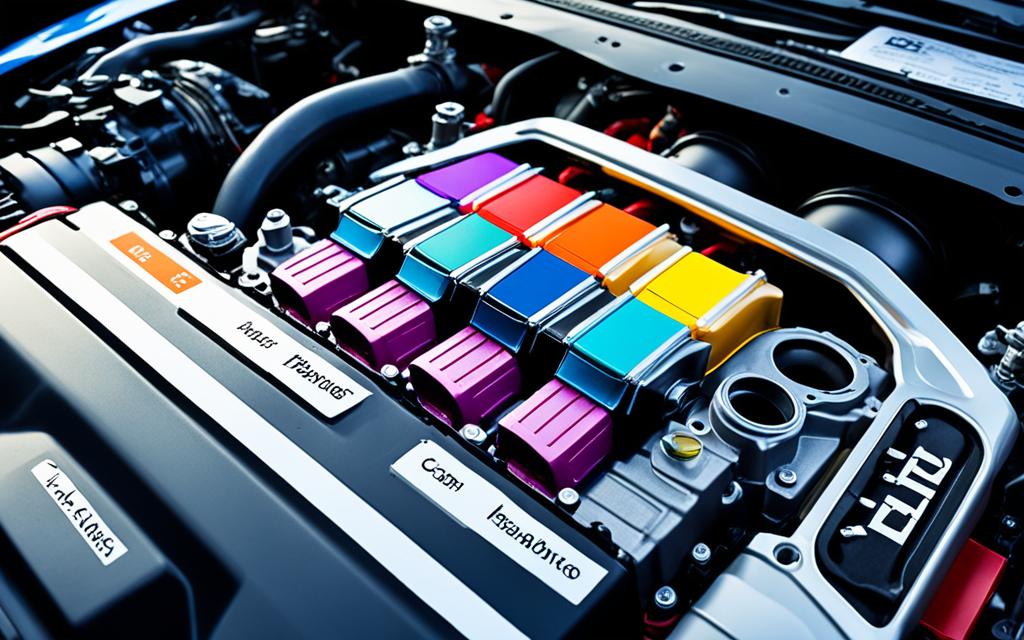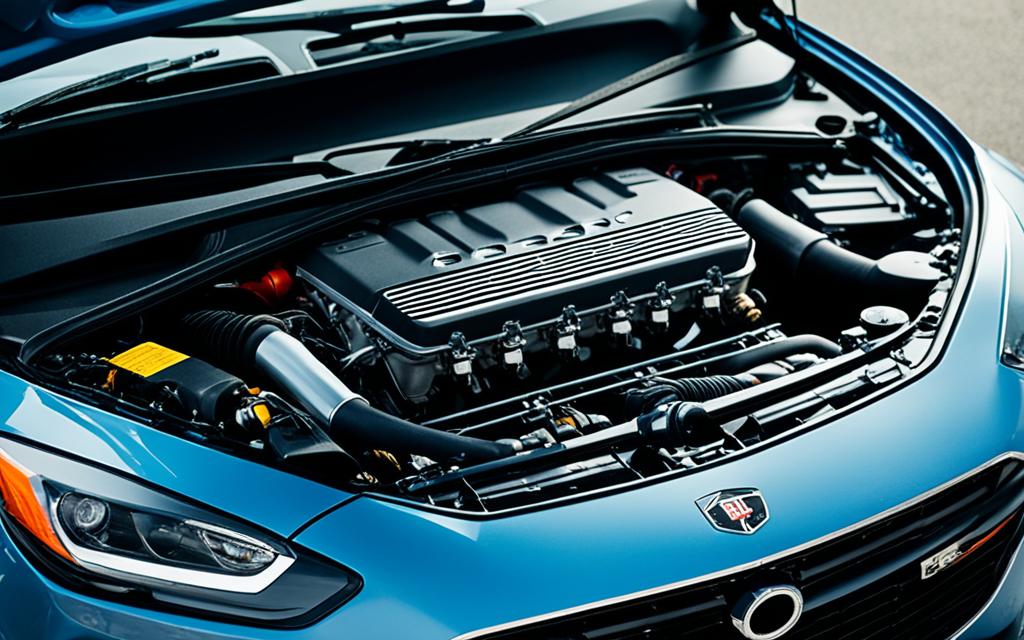Welcome to our quick and easy guide on how to identify the engine in your car. Whether you’re curious about the type of engine your car has or need to perform an engine model lookup, we’ve got you covered. Understanding your car’s engine is essential for maintenance, repairs, and overall performance. So let’s dive in and unravel the mysteries of car engines!
Key Takeaways:
- Knowing the engine type in your car is crucial for maintenance and repairs.
- There are various types of car engines available in the market.
- The Engine Identification Number (VIN) is a vital identifier for your car’s engine.
- Decoding engine labels and stamps can provide specific details about your engine.
- Understanding engine specifications helps decipher important information about your car’s engine.
Now that we’ve set the stage, let’s begin by understanding the different types of car engines commonly found in vehicles.
Understanding Different Car Engine Types
Before we dive into how to identify your car’s engine, let’s familiarize ourselves with the various types of car engines available in the market. This section will give you an overview of the different engine types commonly found in vehicles.
“The engine is the heart of any vehicle.”
– John Smith, Car Enthusiast
Car engines come in various types, each with its own characteristics and advantages. Here are some of the most common car engine types:
- Gasoline/Petrol Engine: This is the most widely used engine type in passenger cars. Gasoline engines run on petrol and utilize internal combustion to generate power.
- Diesel Engine: Diesel engines are known for their efficiency and torque. They run on diesel fuel and are commonly found in larger vehicles such as trucks and buses.
- Hybrid Engine: Hybrid engines combine an internal combustion engine with an electric motor. This combination allows for improved fuel efficiency and reduced emissions.
- Electric Engine: Electric engines run solely on electricity. They are powered by rechargeable batteries and offer zero-emission driving.
- Rotary Engine: Also known as a Wankel engine, rotary engines use a unique rotary design instead of traditional pistons. They provide high power output in a compact size.
| Engine Type | Advantages |
|---|---|
| Gasoline/Petrol Engine | – Widely available – Lower initial cost – Easier maintenance |
| Diesel Engine | – Better fuel efficiency – High torque output – Longer lifespan |
| Hybrid Engine | – Improved fuel economy – Reduced emissions – Regenerative braking |
| Electric Engine | – Zero-emission driving – Low operating costs – Quieter operation |
| Rotary Engine | – Compact size – High power output – Smooth operation |
Each car engine type has its own pros and cons, and understanding these differences can help you make informed decisions about your vehicle. In the next section, we will guide you on how to locate the engine identification number (VIN) to further identify your car’s engine.
Locating the Engine Identification Number (VIN)
The Engine Identification Number (VIN) serves as a critical identifier when it comes to finding valuable details about your car’s engine. By locating this unique number, you can easily perform a vehicle engine search and access engine model lookup information. In this section, we will guide you on how to locate the VIN and utilize it to find relevant engine details.
To find the Engine Identification Number (VIN), follow these steps:
- Open your car’s driver-side door and locate the VIN plate on the door frame.
- The VIN plate typically contains various information, including the VIN itself.
- The VIN consists of a combination of letters and numbers, usually 17 characters long.
- Note down the VIN carefully, ensuring accuracy.
Once you have the VIN, you can now use it to perform a vehicle engine search and access engine model lookup information. Many online platforms and databases allow you to enter the VIN and retrieve comprehensive details about your car’s engine, including its specifications, production year, and more.
Performing a vehicle engine search using the VIN can help you gain valuable insights into your engine’s unique features and characteristics. Whether you need to order specific parts, determine compatibility, or even gauge performance capabilities, the engine model lookup information obtained through your VIN can prove to be highly beneficial.
Tip: Remember to double-check the accuracy of your VIN when performing a vehicle engine search. Even a small error in inputting the VIN can yield incorrect results. If you encounter any difficulties or discrepancies, consult the vehicle’s official documentation or contact a trusted automotive professional for assistance.
Benefits of VIN-based Vehicle Engine Search |
Engine Model Lookup Information |
|---|---|
| 1. Obtain accurate details about your car’s engine specifications. | 1. Identify the exact model and variant of your engine. |
| 2. Determine the production year and manufacturing location of your engine. | 2. Access information about the engine’s power output and torque. |
| 3. Verify the compatibility of engine components when ordering replacements. | 3. Discover any available recalls or service campaigns related to the engine. |
| 4. Access important technical information and specifications for maintenance purposes. | 4. Explore fuel efficiency ratings and emission standards compliance. |
By utilizing the unique Engine Identification Number (VIN), you can easily perform a vehicle engine search and unlock a wealth of information about your car’s engine. Engine model lookup details obtained through this process will help you make informed decisions regarding maintenance, repairs, and customization.
Decoding Engine Labels and Stamps
Engine labels and stamps play a crucial role in providing valuable information about your car’s engine. By learning how to decode these labels and stamps, you can uncover key specifications such as engine displacement, horsepower, and more. Let’s dive into the process of deciphering these codes and understanding what engine your car has.
Decoding Engine Labels
Engine labels are typically located on the engine block or valve cover. These labels often contain a combination of letters and numbers that signify important details about the engine. Here’s a breakdown of what each code represents:
- Engine Model Code: This code indicates the specific model or series of the engine.
- Production Date Code: This code reveals the month and year the engine was manufactured.
- Displacement Code: This code denotes the engine’s displacement, which represents the total volume of all cylinders in the engine.
- Power Output Code: This code illustrates the engine’s power output or horsepower.
- Fuel Type Code: This code specifies the type of fuel the engine runs on, such as gasoline or diesel.
By understanding the meaning behind each code, you can gather valuable information about your car’s engine and its capabilities.
Decoding Engine Stamps
Engine stamps are typically found on various engine components, including the engine block and cylinder head. These stamps often consist of alphanumeric codes that provide specific details about the engine’s characteristics. Here’s what you need to know:
- Serial Number: The serial number stamp identifies the unique identification number assigned to the engine for tracking and manufacturing purposes.
- Casting Number: The casting number stamp represents the specific mold used to manufacture the engine block.
- Engine Code: The engine code stamp signifies the specific engine type, including the number of cylinders and other distinguishing features.
- Assembly Plant Code: The assembly plant code indicates where the engine was manufactured and assembled.
By decoding these stamps, you can gain insights into your car’s engine origin, manufacturing details, and more.
| Code | Meaning |
|---|---|
| Engine Model Code | Specific model or series of the engine |
| Production Date Code | Month and year of engine production |
| Displacement Code | Total volume of engine cylinders |
| Power Output Code | Engine’s power output or horsepower |
| Fuel Type Code | Type of fuel the engine runs on |
| Stamp | Meaning |
|---|---|
| Serial Number | Unique identification number for tracking |
| Casting Number | Specific mold used to manufacture the engine block |
| Engine Code | Specific engine type and features |
| Assembly Plant Code | Location of engine manufacturing and assembly |
Understanding Engine Specifications
When it comes to understanding your car’s engine, engine specifications play a crucial role. These specifications provide valuable information about the engine, including its size, power, and other relevant details. By decoding and interpreting these specifications, you can gain insights into your car’s performance and capabilities.
Let’s take a closer look at the key components of engine specifications:
1. Engine Displacement
Engine displacement refers to the total volume of all cylinders in the engine. It is typically measured in liters (L) or cubic centimeters (cc). Engine displacement affects the engine’s power output, with larger displacements generally indicating higher horsepower and torque.
2. Horsepower
Horsepower (hp) is a measure of the engine’s power or the rate at which it can perform work. It represents the engine’s ability to generate force and is an important indicator of its overall performance.
3. Torque
Torque is the twisting force generated by the engine that allows it to rotate or turn. It is commonly measured in pound-feet (lb-ft) or Newton meters (Nm). Torque is crucial for powering your car’s acceleration and maintaining speed while overcoming resistance.
4. Compression Ratio
The compression ratio tells us the relative volume of the engine’s combustion chamber when the piston is at its lowest (bottom dead center) and highest (top dead center) positions. It affects the engine’s efficiency, power output, and fuel consumption. Higher compression ratios often result in greater engine efficiency.
5. Fuel System
The fuel system determines how fuel is delivered and mixed with air for the combustion process. Common types of fuel systems include carbureted and fuel-injected systems. The fuel system directly affects the engine’s performance, efficiency, and emissions.
Understanding these engine specifications will not only help you make informed decisions about your car but will also aid in proper maintenance and care. By knowing the size, power, and other relevant details of your engine, you can ensure that it operates at its best and optimize its performance and longevity.
Now let’s delve into an illustrative table that summarizes the engine specifications for various sample car models:
| Car Model | Engine Displacement (L) | Horsepower (hp) | Torque (lb-ft) | Compression Ratio | Fuel System |
|---|---|---|---|---|---|
| Ford Mustang GT | 5.0 | 450 | 410 | 12.0:1 | Fuel Injection |
| Toyota Camry | 2.5 | 206 | 186 | 13.0:1 | Fuel Injection |
| Honda Civic | 1.5 | 174 | 162 | 10.6:1 | Fuel Injection |
By referring to this table, you can easily compare the engine specifications of different car models and gain insights into how they differ in terms of engine size, power, and more.
Now that you have a better understanding of engine specifications, you can confidently decode and interpret these details to unlock the full potential of your car’s engine.

Identifying Engine Components
To further understand your car’s engine and accurately identify its type, it’s crucial to familiarize yourself with the various components that make up an engine. By recognizing and understanding these components, you’ll be better equipped to determine what engine your car has. Let’s explore the major engine components and their roles within the overall engine system.
Main Engine Components
The main engine components consist of:
| Component | Description |
|---|---|
| Pistons | The pistons move up and down within the cylinders, converting fuel energy into mechanical energy. |
| Cylinders | These cylindrical chambers house the pistons and allow combustion to occur. |
| Valves | Valves control the flow of fuel and air into the cylinders and the flow of exhaust gases out of the cylinders. |
| Crankshaft | The crankshaft converts the up and down motion of the pistons into rotational motion, which drives the vehicle’s wheels. |
| Camshaft | The camshaft controls the opening and closing of the valves, coordinating their operation with the movement of the pistons. |
| Timing Belt/Chain | The timing belt or chain synchronizes the crankshaft and camshaft, ensuring that the valves open and close at the correct time. |
Other Engine Components
In addition to the main components mentioned above, there are various other engine components that contribute to its operation and performance. These include:
- Fuel injectors
- Intake manifold
- Exhaust manifold
- Engine block
- Oil pump
- Coolant system
- Ignition system
This is not an exhaustive list, but it provides an overview of the key components you should be familiar with when identifying your car’s engine.
Understanding the different engine components is like learning the alphabet to decipher the language of engines. Once you can identify and understand these components, you’ll have a solid foundation for determining your car’s engine type.
Now that you have a better understanding of the major engine components, you’re ready to move on to the next step in our engine identification guide. In the next section, we’ll explore how to locate the Engine Identification Number (VIN) to further assist you in identifying your car’s engine.
Online Resources for Engine Research
When it comes to researching your car’s engine, the internet can be a valuable tool. There are numerous online resources and databases available to help you find accurate and detailed information about your engine. Whether you need to look up car engine specs, search for a specific engine model, or perform a vehicle engine search, these resources can provide you with the information you need.
Here is a list of some of the top online resources for engine research:
- Carfax: Carfax provides a wealth of information about vehicle history, including engine details. You can enter your car’s VIN or license plate number to access engine specifications and other relevant data.
- Edmunds: Edmunds is a popular automotive website that offers a comprehensive database of car information. You can find engine details, specifications, and reviews for various makes and models.
- NHTSA: The National Highway Traffic Safety Administration’s website provides a range of resources for vehicle owners. You can access safety ratings, recalls, and other important information, including engine specifics.
If you’re looking for more specialized resources, there are also dedicated forums and communities where car enthusiasts and experts discuss engines and provide valuable insights. Websites like CarForum and Engine Builder can be great places to seek advice from knowledgeable individuals.
Remember, these online resources can help you gather information about your car’s engine, but it’s essential to cross-reference the data with official sources and consult your vehicle’s manufacturer or trusted mechanics for accurate and reliable information.
Seeking Professional Assistance
If you’re still uncertain or overwhelmed by the process of identifying your car’s engine, don’t hesitate to seek professional help. Finding trusted mechanics or experts who specialize in car engines can provide valuable insights and guidance in determining your engine type.
These professionals have extensive knowledge and experience in working with various car engine types, making them well-equipped to assist you in your search for engine identification. They can assess the unique characteristics of your vehicle and guide you towards accurate engine model lookup.
By consulting with a professional, you can save time and effort, avoiding potential mistakes or misinterpretations during the engine identification process. They can also provide additional maintenance and care tips specific to your car’s engine type, ensuring its longevity and optimal performance.
How to Find Trusted Mechanics or Experts
When searching for professional assistance with identifying your car’s engine, consider the following:
- Ask for recommendations from friends, family, or fellow car enthusiasts who have previously sought engine identification help.
- Look for specialized car repair shops that focus on engine diagnostics and repairs.
- Check online directories and reviews to find reputable professionals in your area.
- Reach out to local car clubs or enthusiast groups for recommendations and referrals.
Remember to ask the professionals about their experience and expertise in engine identification. It’s important to choose someone who has a deep understanding of different car engine types and can provide accurate information specific to your vehicle.
| Benefits of Seeking Professional Assistance | Considerations when Choosing a Professional |
|---|---|
|
|
Seeking professional assistance can be a valuable resource in your journey of identifying your car’s engine type. Their expertise and guidance can provide you with the confidence and clarity you need to make informed decisions about your vehicle’s maintenance and future repairs. Don’t hesitate to reach out to trusted mechanics or experts who can help you uncover the secrets of your car’s engine.

Maintenance and Care Tips
Proper maintenance and care are crucial for keeping your car’s engine running smoothly and efficiently. By following these essential tips and guidelines, you can ensure the longevity and optimal performance of your engine.
1. Regular Oil Changes
One of the most important maintenance tasks for your car’s engine is regular oil changes. Engine oil lubricates and protects the moving parts, preventing wear and tear. Refer to your vehicle’s manual for the recommended oil change interval and use the appropriate type of oil for your engine.
2. Check and Replace Filters
Filters, such as the air filter and fuel filter, play a vital role in maintaining the clean and efficient operation of your engine. Regularly inspect these filters and replace them as needed to ensure optimal airflow and fuel delivery to the engine.
3. Monitor Coolant Levels
Coolant, or antifreeze, is essential for regulating the engine’s temperature and preventing overheating. Regularly check the coolant levels and top up when necessary. Remember to use the recommended coolant type for your specific engine.
4. Keep an Eye on Belts and Hoses
Inspect the belts and hoses in your engine compartment regularly for signs of wear, cracks, or leaks. Replace any damaged belts or hoses promptly, as they are crucial for the proper functioning of the engine’s cooling system and other components.
5. Perform Regular Tune-Ups
Schedule regular tune-ups for your engine to ensure optimal performance. This may include checking and adjusting ignition timing, spark plug replacement, and inspecting the ignition system.
Proper maintenance and care are crucial for keeping your car’s engine running smoothly and efficiently.
Remember, always consult your vehicle’s manual for specific maintenance recommendations and intervals. By taking good care of your engine and staying on top of regular maintenance tasks, you can enjoy a reliable and efficient driving experience for years to come.
| Car Engine Maintenance Tips |
|---|
| Regular oil changes |
| Check and replace filters |
| Monitor coolant levels |
| Keep an eye on belts and hoses |
| Perform regular tune-ups |
Conclusion
In conclusion, identifying your car’s engine doesn’t have to be a challenging task. By following the steps and tips outlined in this guide, you can confidently determine your engine type and access the necessary information for maintenance and repairs. It is essential to locate the Engine Identification Number (VIN) and decode engine labels and stamps to gather important specifications about your engine. Understanding engine components and specifications will further enhance your knowledge of your car’s engine.
Online resources and databases can provide valuable assistance in your engine research journey. However, if you’re unsure or overwhelmed, don’t hesitate to seek professional help from trusted mechanics or experts. They can provide expert guidance in identifying your engine type and offering tailored maintenance advice.
Remember, properly maintaining and caring for your engine is crucial for its longevity and efficiency. By understanding your car’s engine type, you can adopt the appropriate maintenance practices to keep it running smoothly. Whether it’s regular check-ups, oil changes, or handling minor repairs, taking care of your engine will ensure its optimal performance.
FAQ
How can I identify the type of engine in my car?
To identify the type of engine in your car, you can start by checking the owner’s manual or the vehicle’s registration documents. Alternatively, you can also look for the engine identification number (VIN) located on the engine block. This VIN can be used to find the relevant engine details through online resources or by consulting professionals.
What is a car engine decoder?
A car engine decoder is a tool or resource that helps in decoding the engine identification number (VIN) to provide specific details about the engine’s type, specifications, and other relevant information. It enables you to decode the alphanumeric codes and understand the characteristics of your car’s engine.
How do I find the Engine Identification Number (VIN)?
The Engine Identification Number (VIN) is usually located on the engine block or the vehicle’s firewall. It can also be found on the vehicle registration documents or the driver’s side door jamb. Look for a series of alphanumeric characters typically consisting of 17 digits. This number is unique to each vehicle and can be used to determine the engine type.
How can I decode engine labels and stamps?
Decoding engine labels and stamps involves understanding the codes, numbers, and symbols present on them. These labels and stamps provide information about the engine’s displacement, horsepower, manufacturing date, and other specifications. To decode them, you can refer to the owner’s manual, online resources, or consult professionals who are familiar with the specific engine brand or model.
What are engine specifications and how can I understand them?
Engine specifications refer to the detailed information about your car’s engine, including its size, power output, fuel type, and other relevant details. Understanding these specifications can help you make informed decisions regarding maintenance and repairs. To comprehend the specifications, you can refer to the owner’s manual, manufacturer’s website, or online resources that provide explanations and guides for interpreting engine specifications.
What are the major components of a car engine?
The major components of a car engine include the engine block, cylinder head, pistons, crankshaft, camshaft, valves, connecting rods, and spark plugs. Each component plays a crucial role in the combustion process and overall performance of the engine. Familiarizing yourself with these components can help in identifying and understanding your car’s engine type.
Are there online resources for researching car engines?
Yes, there are several online resources and databases available for researching car engines. Websites such as VIN decoder platforms, manufacturer websites, and vehicle history report providers offer engine-related information. These resources allow you to search by VIN or vehicle make and model to access engine specifications, service history, and other relevant details.
What should I do if I need professional assistance in identifying my car’s engine?
If you’re unsure or find it overwhelming to identify your car’s engine, it’s recommended to seek professional assistance. Professional mechanics or engine experts have the knowledge and tools to accurately determine your engine type. They can also provide guidance on maintenance, repairs, and any other specific concerns you may have regarding your car’s engine.
How can understanding my car’s engine type help with maintenance and care?
Understanding your car’s engine type is crucial for proper maintenance and care. It helps you identify the correct replacement parts, determine the appropriate maintenance intervals, and diagnose potential issues accurately. Knowing the specific requirements of your engine enables you to follow manufacturer-recommended guidelines, ensuring optimal performance, fuel efficiency, and longevity of your car’s engine.








